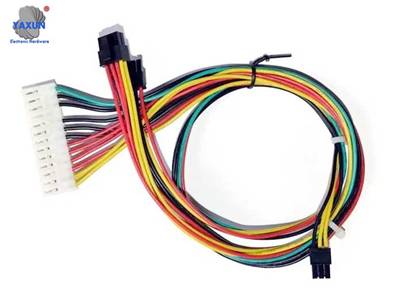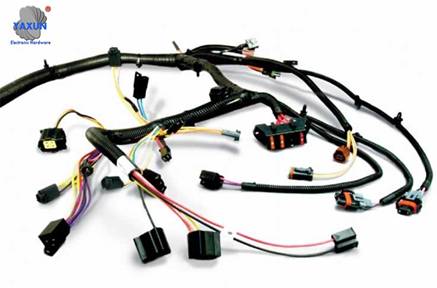The wiring harness consists of two elements: wires (signal wires, power wires) and connectors.
In addition to electronic components, wire harnesses are also indispensable in electronic products. Although many products use board-to-board connectors in place of wires, most electronic devices still cannot be separated from wire harnesses in terms of signal and power transmission. A wire harness usually consists of wires, pistikud, jacketing, or insulation. The editor of YAXUN Electronic Connectors will discuss with you the role relationship between signal lines, power lines and connectors in the wiring harness.

Power connection harness

Power and signal cables
As the name suggests, signal lines mainly refer to the lines used to transmit sensing information and control information in electrical control circuits. Signal lines usually consist of multiple cables forming one or more transmission lines, or they can also be printed circuits arranged in a printed circuit board. With the continuous advancement of science, technology and applications, signal lines have developed from metal carriers to other carriers, such as optical cables. In order to facilitate standardized production and application, signal lines for different purposes usually have different industry standards.
Power lines are wires that carry electrical current. Typically, point-to-point is how electricity is transmitted. Power cords can be divided into DC power cords and AC power cords according to their uses. Üldiselt, AC power lines are wires that pass high-voltage alternating current. Kõrgepinge tõttu, this type of wire cannot be officially produced until it obtains safety certification according to unified standards. DC DC lines basically pass through a lower voltage DC power supply, so the safety requirements are not as strict as AC AC lines. Siiski, for security reasons, countries still need unified security certification.
The big difference between signal lines and power lines is that signal lines transmit analog signals or digital signals, and power lines are used to transmit current. Signal lines refer to lines that transmit data, and power lines refer to circuits that provide power. In fact, electrical signals also run in signal lines, which are just regular, arranged, and information-carrying electrical signals. The power cord only carries DC current with a fixed voltage value. In electronic equipment, connectors function without causing signal absorption, attenuation, and power loss to system performance. It also provides detachable connection devices between electronic systems. Seetõttu, a wire is needed to connect between them.
Signal lines, power lines, and connectors can exist independently or coexist. If there are signal and power transmission requirements in electronic products, how can there be fewer connectors? Seetõttu, these three are interdependent and coexisting, and are indispensable in electronic products.
The above is what the editor shared, I hope it will be helpful to everyone. YAXUN Electronics provides integrated R&D and production services from the development of plastic and hardware terminal molds for products, to precision plastic injection molding, high-speed stamping of precision hardware terminals, terminal plating, and automated assembly of wire harnesses. If you need more detailed information, you can contact the staff for consultation.
 English
English العربية
العربية Български
Български 中文(漢字)
中文(漢字) Čeština
Čeština Dansk
Dansk Eesti keel
Eesti keel Suomi
Suomi Français
Français Deutsch
Deutsch Ελληνικά
Ελληνικά עברית
עברית Magyar
Magyar Bahasa Indonesia
Bahasa Indonesia Italiano
Italiano 日本語
日本語 한국어
한국어 Latīna
Latīna Latviešu valoda
Latviešu valoda Lëtzebuergesch
Lëtzebuergesch Polski
Polski Português
Português Română
Română Русский
Русский Slovenščina
Slovenščina Español
Español Svenska
Svenska ภาษาไทย
ภาษาไทย Tiếng Việt
Tiếng Việt
